 |
|
|



On a fretted Alembic instrument, the fingerboard wood is not a huge factor in the tone produced,
since the notes are created when you touch the string to a fret. You are free to consider only
practical or aesthetic ideals when selecting your fingerboard. If you are are ordering a fretless
bass, then the fingerboard wood you choose will greatly affect the sound you make with your bass.
Our fingerboards are thick and will take many resurfacings and refrettings before replacement is required.

|
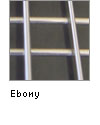 Ebony is our first choice for fingerboards. It's extremely durable
and will outlast any other commercially available wood. Ebony is very dense with a
consistent touch that is not sticky or tacky. The color is a rich, deep black. The finest
orchestral instruments feature Ebony fingerboards.
Ebony is our first choice for fingerboards. It's extremely durable
and will outlast any other commercially available wood. Ebony is very dense with a
consistent touch that is not sticky or tacky. The color is a rich, deep black. The finest
orchestral instruments feature Ebony fingerboards.
 For fretless basses, Ebony offers the most versatile sound. Unmatched for smooth
glissando, Ebony adds a melodic quality to the tone. Growly sounds are possible, but
take a little more effort on the part of the player to produce.
For fretless basses, Ebony offers the most versatile sound. Unmatched for smooth
glissando, Ebony adds a melodic quality to the tone. Growly sounds are possible, but
take a little more effort on the part of the player to produce.
 We supply our Ebony fingerboards with a light oil finish that needs to be replenished
as you play. 100% pure essential lemon oil is recommended about once a year, or any time
you notice the wood looking particularly dry or dirty - the oil will clean as well as
condition the fingerboard.
We supply our Ebony fingerboards with a light oil finish that needs to be replenished
as you play. 100% pure essential lemon oil is recommended about once a year, or any time
you notice the wood looking particularly dry or dirty - the oil will clean as well as
condition the fingerboard.
|
 |
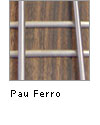 We supply Pau Ferro on our Excel basses and by custom request on other models.
Pau Ferro translates to "iron wood" from Portuguese, so you know the stuff is tough. It's
nearly as hard as Ebony, but it has a slightly sticky feel because of the higher resin content of the wood.
We supply Pau Ferro on our Excel basses and by custom request on other models.
Pau Ferro translates to "iron wood" from Portuguese, so you know the stuff is tough. It's
nearly as hard as Ebony, but it has a slightly sticky feel because of the higher resin content of the wood.
 If you are looking for a "no-brainer" growly sound for fretless, Pau Ferro is your wood. It's not
as versatile as Ebony, but if your tone doesn't require that flexibility, you may be better off
with the automatic growl of Pau Ferro.
If you are looking for a "no-brainer" growly sound for fretless, Pau Ferro is your wood. It's not
as versatile as Ebony, but if your tone doesn't require that flexibility, you may be better off
with the automatic growl of Pau Ferro.
 Care for Pau Ferro is the same as that for Ebony.
Care for Pau Ferro is the same as that for Ebony.
|
 |
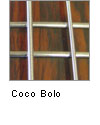 Part of the Rosewood family, Coco Bolo makes an excellent fingerboard. It's not quite as hard as Ebony,
but you still shouldn't have to replace your fingerboard for many years. Our fingerboards are
supplied as unfinished, and some people are sensitive to the oils in Coco Bolo. Coco Bolo is not
suitable for those with sensitive skin. Like any unfinished fingerboard, Coco Bolo needs to be
oiled once or twice a year to replace the heavy turpines and other large molecules that evaporate over time.
Part of the Rosewood family, Coco Bolo makes an excellent fingerboard. It's not quite as hard as Ebony,
but you still shouldn't have to replace your fingerboard for many years. Our fingerboards are
supplied as unfinished, and some people are sensitive to the oils in Coco Bolo. Coco Bolo is not
suitable for those with sensitive skin. Like any unfinished fingerboard, Coco Bolo needs to be
oiled once or twice a year to replace the heavy turpines and other large molecules that evaporate over time.
 As with all Rosewood fingerboards, Coco Bolo wears well and has a very slightly tacky touch. It's a good
middle ground between Ebony and Pau Ferro. It offers a fair amount of growl without much effort,
but retains access to more melodic sounds.
As with all Rosewood fingerboards, Coco Bolo wears well and has a very slightly tacky touch. It's a good
middle ground between Ebony and Pau Ferro. It offers a fair amount of growl without much effort,
but retains access to more melodic sounds.

|
 |
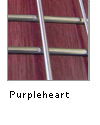 Purpleheart is another option for fingerboards. It's nice and dense, so it will wear well. Over time, Purpleheart
will darken like most woods. We can supply either oiled or with a light polyurethane finish if you want to protect
the color somewhat.
Purpleheart is another option for fingerboards. It's nice and dense, so it will wear well. Over time, Purpleheart
will darken like most woods. We can supply either oiled or with a light polyurethane finish if you want to protect
the color somewhat.
 The primary reason for selecting Purpleheart for the fingerboard is for the color. We think it looks especially
nice paired with a Maple top and the classic Alembic neck combination of Maple and Purpleheart.
The primary reason for selecting Purpleheart for the fingerboard is for the color. We think it looks especially
nice paired with a Maple top and the classic Alembic neck combination of Maple and Purpleheart.
|
 |
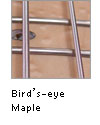 There was a solid twenty years of exclusively Ebony fingerboards, there was but one or two Alembics with a Maple fingerboard.
What can we say, after making a bunch of custom basses between 2010-2013, we've been converted: Maple is cool! Especially under a
nice finish so it doesn't get grungy. This example has ablone inlays.
There was a solid twenty years of exclusively Ebony fingerboards, there was but one or two Alembics with a Maple fingerboard.
What can we say, after making a bunch of custom basses between 2010-2013, we've been converted: Maple is cool! Especially under a
nice finish so it doesn't get grungy. This example has ablone inlays.

|
 |
© 2014 Alembic, Inc.
|
|
|

